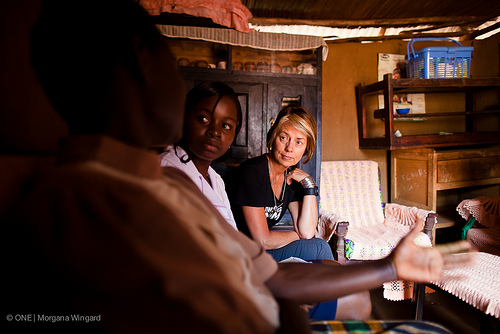From July 25 through July 30, anti-poverty advocacy group ONE joined 10 bloggers who made their way through Kenya to see what life is really like for moms in the developing world. Follow along and check their progress at http://one.org/us/actnow/moms.
I began the day dancing. Literally. Head bobbing, hands in the air, face beaming. And I wasn't alone.
This morning we ONE Moms bumped along dirt roads in our bus, emerged into a clearing and then were swallowed up in a swarm of colorful women. Yelping into song and dance, they swept us forward into their rhythm mosh pit-style, and I felt joy. I hadn't expected joy.
Because in Kenya, moms and babies are dying. Way too many. The stats are alarming:
- 1 in 10 babies die in their first year, and of those, 60 percent die in their first week of life.
Really? Sooooo much effort was being invested into saving moms and children from HIV-AIDS... only to have them die in childbirth? No.
Today I saw a great success story. A tale of digging in and making a difference in a big way.

The dancing stopped and we fell into chairs and exchanged introductions. We'd arrived at the Lwak Nutritional Center, in Kisumu, a program focusing on maternal and child health. Recently, they've undertaken -- in partnership with ONE -- an amazing study that follows pregnancies, birth outcomes and the health of children in a variety of stages of maternity, in order to learn what works best for moms and babies to live. The dancing women -- it turned out -- were known as village reporters, elected by their communities to traipse through muddy paths to personally check on new moms and their babies, reporting back their progress to the Center for Disease Control.
After hearing from a guest traditional birth attendant as to how she treats women in delivery with herbs scoured from the country side to "turn the baby," here's how I felt: YIKES!
Our team then hiked our way up a rocky crevice to the home of Lillian and her new baby, Emily. Accompanied by our very own village reporter -- also named Emily -- we learned that Lillian had tried to make it to the hospital but her labor was too strong and ended up in the untrained attendant's home. We sat on the edge of the bench and were relieved to learn that all had gone well. But when village reporter Emily made her post-delivery visit to Lillian, she discovered that the baby had a deformity in her legs and not only advised Lillian to take her to the hospital pediatrician but arranged for transportation. As we met little Emily, we all rejoiced that she'd been attended to early -- preventing permanent deformity.

Too many moms and children still die in childbirth in Kenya. The solutions to complete health are multi-layered. We cannot address one issue and overlook others. As one doctor put it, "No woman should die while giving forth to life."
Today I met Lillian and Emily who both lived. Yes, today there was reason to dance.
This post was originally published on 08/14/2011 and is being re-featured for HuffPost Global Motherhood.